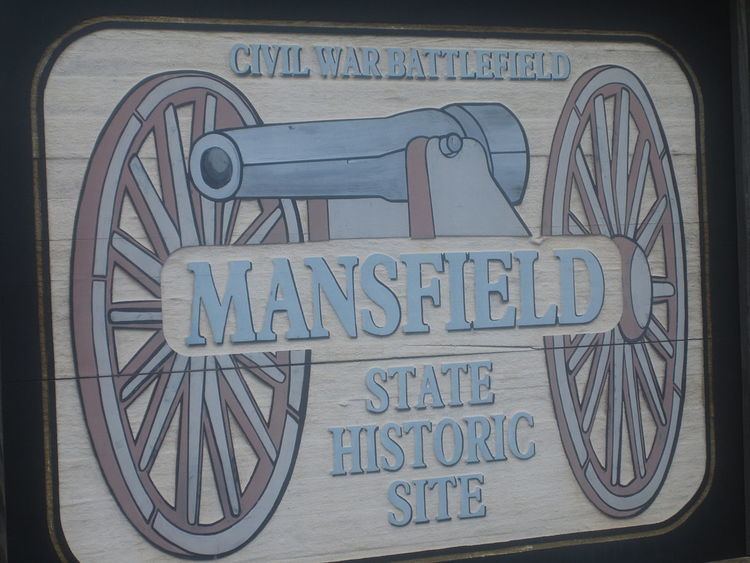Phone +1 318-872-1474 | ||
 | ||
Address 15149 LA-175, Mansfield, LA 71052, USA Hours Closed today MondayClosedTuesdayClosedWednesday9AM–5PMThursday9AM–5PMFriday9AM–5PMSaturday9AM–5PMSunday9AM–5PM Similar Rebel State Historic S, Fort Jesup, Centenary College of Louisiana, Plaquemine Lock State Historic S, Marksville Prehistoric Indian Site | ||
Cannon firing at mansfield state historic site
Mansfield State Historic Site is a Louisiana state historic site which preserves the site of the 1864 Battle of Mansfield in the American Civil War. It is located four miles south of Mansfield, the seat of DeSoto Parish in northwestern Louisiana. The battle is considered significant because Confederate troops succeeded in the overall Red River Campaign in turning back large Union forces, preventing the progression of the war into Texas, and perhaps delaying the final southern surrender on April 9, 1865.
The Union expected the Red River Campaign to lead to the seizure of cotton for New England mills, to prevent a French-Mexican force from joining the Confederates, and provide protection for Union loyalists in Texas and bring the state back into the Union. The capture of Shreveport, then the Louisiana capital as well as headquarters of Trans-Mississippi Confederate operations, was another Union goal. The Union army and navy progressed through Alexandria and reached Natchitoches by early April 1864. The army separated from the navy at Natchitoches and veered toward Mansfield, a situation which left ground troops without naval backup.
Confederate General Richard Taylor, son of U.S. President and General Zachary Taylor, decided to challenge the Union at Mansfield, rather than waiting until Union commander Nathaniel P. Banks reached Shreveport. This tactic allowed Taylor to face the enemy on more equal terms because the Confederate troops were heavily outnumbered. At noon on April 8, 1864, some 6,400 Union troops faced 10,500 Confederates. The Union formed a line of battle along a rail fence and ridge called "Honeycutt Hill". On orders from Taylor, General Alfred Mouton and his division charged the rail fence. Mouton was killed in the attack, but General Camille Armand de Polignac, a native of France, continued the advance and overwhelmed Union troops. In a plaque in the museum Taylor is quoted as having said: "The death of the gallant Mouton affected me. He joined me soon after I reached Western Louisiana and had ever proven faithful to duty. Modest, unselfish, and patriotic, he showed best in action, always leading his men." In addition to the monument in his honor, Mouton is honored with an interpretative nature trail in the park.
An infusion of two thousand Union troops failed to change the outcome, as Taylor and his men took many prisoners and seized the weaponry and wagons abandoned by the enemy. Fighting continued the next day at the Battle of Pleasant Hill in Sabine Parish south of Mansfield. A military draw at Pleasant Hill caused the Union to retreat south toward Alexandria.
The battle site encourages visitor to "step back in time" through its living history events, military exhibits, a film, battle reenactments, musket demonstrations, and interpretative programs. There are also interpretative trails and a picnic area. Candlelight tours of the battlefields are occasionally offered. Among the exhibits is a picture of Civil War Governor Thomas Overton Moore and the sculpture "Spirit of the Confederacy", based on St. Barbara, patron saint of artillerymen. There is a model of the ship, USS Carondelet. The museum also contains a replica of a field campsite and a collection of medical instruments required to treat the wounded from battle.
A large celebration was held for the centennial of the battle in 1964. Lieutenant Governor of Texas Preston Smith and F. Jay Taylor, an historian of the Civil War who was then president of Louisiana Tech University at Ruston, led the processions. Smith, who later served as governor from 1969-1973, headed an eight-mile caravan of vehicles from Texas, which supplied Confederate troops at Mansfield.
The Texas Tech University historian Alwyn Barr in 1998 released the second edition of his Polignac's Texas Brigade, a study of Polignac and the Texan who fought in Mansfield and then Sabine Crossroads.
